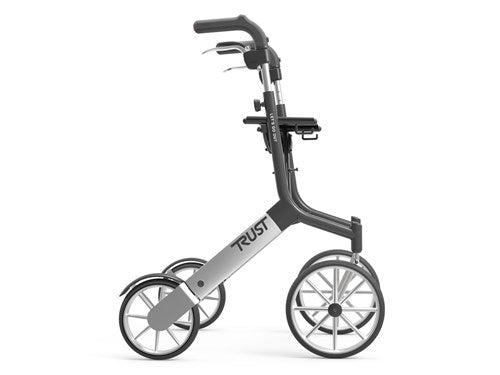Orders over £100

Bed Aids for the Disabled and Elderly: Bed Aids for Sitting Up
Many types of bed aids are available to support your bed and improve your time in it, such as bedding protectors, bed raisers, and bed trays.
A subcategory within bed aids includes those that help you sit up and get out of bed, which can help anyone who uses a mobility aid, such as a wheelchair or rollator. The Trust Rollator, in particular, is designed to make movement easy while you’re out and about, but a bed aid can help you when the rollator can’t—when you’re going to bed.
Mobility aids for getting out of bed can help you increase your independence and safely exit the bed, reducing your risk of injury and making them a beneficial addition for anyone who experiences difficulty getting in and out of bed.
What Types of Bed Aids Are There?
While there are a range of bed aids, in this article we will focus only on those that help you get out of bed. Some are specific for the bed, but others have greater functionality and can also be used when getting up from a chair or couch.
Standing Aids
Standing aids offer a handle to hold onto and lean against as you get up. They generally go on the side of the bed so you can grab onto them when sitting up and getting out of bed.
The benefit of a standing aid is that it does not take up much space but still offers a sturdy object to push against as you stand up. Standing aids can also be used to press up to sitting, allowing them to help with each step of the getting-out-of-bed process.
Standing aids can be free-standing or attached to the bed frame. Their handlebar is wide enough to be grasped by two hands, offering even more support, and the handlebar is made of a padded foam that is soft and comfortable to hold and push against as you stand.
Bed Rails
While bed rails are primarily used to prevent anyone from falling out of bed, they serve an additional benefit by being something you can use to get out of bed. Additionally, while the standing aid takes up a small space with a single grab bar, the bed rail extends along the entire bed, offering more places to grab. For some people, this may be preferable.
Bed Hoist or Ladder
A bed hoist or ladder offers rungs to “climb” that help get you into a sitting position. However, unlike the standing aid or bed rails, the bed ladder can only help you get to sitting; it cannot help you stand or transfer to a wheelchair.
Adjustable Beds
An adjustable bed is the best bed for elderly individuals with mobility issues. While much more expensive than the other bed aids, an adjustable bed elevates the mattress to make getting in and out of bed easier by reducing the strain on the muscles.
How Can Bed Aids Help the Disabled and Elderly?
A good night of sleep is crucial to restore your energy levels and allow your body to repair and protect itself. However, some people may have difficulty getting out of bed, which can make mornings stressful.
Bed aids for sitting up make the process of getting into and out of bed easier and less strenuous, which offer additional benefits:
Offers Support
The greatest benefit and use of bed aids is to offer support as you stand up. Standing aids and bed rails, in particular, provide a sturdy handle higher than the bed to grab onto.
Not only can you use the handlebar to press to standing, but the handle also offers support as you steady yourself. This means that, after standing, you still have something to hold onto until your balance is restored and you’re ready to begin moving.
Increases Independence
Independence heavily relies on someone’s ability to move around on their own, and getting into and out of bed can be one of the greatest challenges. This is because getting in and out of bed requires a lot of dexterity and muscle strength, meaning you need to be able to move your limbs into position while also having enough strength to push up.
Those with physical difficulty getting in and out of bed may need a caretaker, especially elderly individuals whose strength is not what it once was. Many people enjoy having a caretaker, but others may not feel ready to forego their complete independence—this is where a bed aid can help.
With a bed aid, you can more easily get out of bed yourself, reducing the need for assistance. For those in a wheelchair, a bed aid can help you get from the bed to the chair, and for those who are elderly, the bed aid can provide the support you need to get out of bed when your muscles may not be strong enough to do it on their own.
Losing your independence can be an isolating feeling that can cause negative emotions to develop. So, any means of retaining independence, such as by continuing to exit your bed on your own, can significantly contribute to your quality of life.
Furthermore, with the increased independence offered by a bed aid, you don’t have to wait for help to arrive to get out of bed. This can be especially significant for those who do not have regular caretakers but have occasional days where they could use extra help getting out of bed. With a bed aid, the help is always there for you to use whenever you need it, as soon as you need it.
Helps You Recover
If you are recovering from an illness or injury that has made it challenging to get into and out of bed, a bed aid can help. By easing the transition out of bed, a bed aid ensures that you don’t cause more injury to yourself at a time when your body needs to focus all its energy on healing the initial concern.
A bed aid can also make the recovery process more pleasant. Without a bed aid, you may have to sleep on the couch after a procedure because it is easier to get up from. However, a bed aid allows you to continue sleeping in your bed, where you’ll get better sleep.
Additional Tips to Make Getting Out of Bed Easier
You’ve already taken a great step for your mobility by using a bed aid, but there are other things you can do to make getting out of bed even easier.
Take It Slow
There’s no race to get out of bed in the morning, and if you do try and race out of bed, you may end up with an injury.
Instead, channel your inner tortoise because slow and steady truly wins this race. All the help of a bed aid means nothing if you try to get out of bed too quickly, especially in the morning when your mind may still be hazy with sleep.
Take it slow when getting out to bed to ensure you don’t slip or take a misstep. Also, start by sitting up and ensuring you’re steady before pushing up to a standing position or switching to your wheelchair.
It might seem simple, but getting out of bed slowly can be the difference between continuing with your day or ending up on the floor with an injury, so don’t brush it aside.
Keep Your Rollator or Wheelchair Close
If you need a rollator or wheelchair to move around, especially in the morning when your body may be stiffer, keep it close to the bed so you can easily transition to it. This may require you to rearrange your furniture so you have the room to place and manoeuvre your mobility assist device, but it’s a change that’s well worth it.
Use An Overbed Table
While this won’t make getting out of bed easier, using an overbed table can reduce the number of times you need to get out of bed since you can place everything in easy reach. This can significantly help those who struggle to get out of bed as it limits how much they need to get up and down.
Making Your Bed Mobility-Friendly
There are many reasons why getting out of bed may be a challenge, some of which include being older or having a disability that affects your mobility. Whatever the reason, there are tools available that can help you get up and out of bed on your own, such as standing aids, bed rails, and adjustable beds.
Bed aids make it easier to get out of bed by offering support. This makes it safer to get out of bed, allowing you to maintain your independence as you continue to get out of bed on your own whenever you want.
Browse our walking and mobility aids to see other ways to get around your home easier.
About the Author

Jessica Guht
Jessica is a freelance medical writer with a Master's degree in Biomedical Engineering.
Learn more about the author on Jessica's website.


